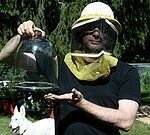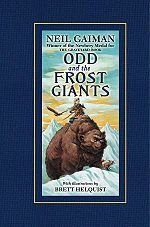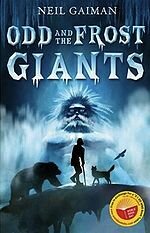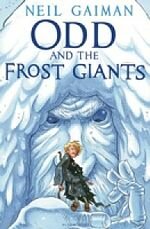Odd and the Frost Giants
From Literary Wiki.org
==Page X==
Sample entry
Information directly relevant to the quotation.
- Tangentially relevant information
- Your own interpretations and insights. Bleakhouse <--Use three ~ to sign your name if you want.
Contents |
Intro
Odd and the Frost Giants' (2008) is a World Book Day book by Neil Gaiman. It's a children's story about a boy named Odd who lives in the days of the vikings and features gods and myths from Norse mythology. Wikipedia, Amazon, Official Page.
Illustrations
The UK edition is illustrated by comic book artist Mark Buckingham, who worked on Fables and Marvelman. The US edition is illustrated by Brett Helquist, who illustrated (among other things) the Lemony Snicket books. A Finnish illustrator named Jouni Koponen is unofficially (officially?) creating a comic book adaptation, which he is posting on his blog.
Spoiler-free Quotes by Gaiman about the work
Gaiman: "It was written for something called World Book Day in the UK, where a bunch of authors write books for nothing, and publishers publish them for nothing, and they get sold for £1 each to kids who have been given £1 Book Tokens, and the whole thing exists purely in order to get kids reading. They describe it on their website as the biggest annual event promoting the enjoyment of books and reading. It was started by UNESCO, borrowing a custom from Catalonia, where roses and books were given as gifts on April 23rd (St George's Day, Shakespeare's birth and death day, not to mention Nobokov's birthday and Cervantes deathday)." (source)
Gaiman: "Roger Lancelyn Green's Myths of the Norsemen was the book that got me hooked when I was six or seven, and I saved up my money and bought a copy of Lancelyn Green's Tales of Ancient Egypt. Both of them are still in print. For older readers who want a grounding in Norse myth, Kevin Crossley-Holland's Norse Myths is marvellous, and I see from his web site he's published a selection of it for younger readers called Viking!" (source)
Gaiman: "Odd is a slim book I'm writing -- a novelette, I guess -- that will be published for World Book Day 2008." (source)
Chapter 1
Page 1
Odd meant the tip of a blade
Gaiman on how he found the name, Odd: "and how I found it? Before I started writing, I called my favourite Norwegian, Iselin Evensen (last seen on this blog taking me to a tomb in Oslo I think), and she put several lists of old Norse names and nicknames and what they meant and suchlike together for me, and Odd jumped out from the list and started waving." source
Page 2
orkney
an archipelago in Northern Scotland. Wikipedia
Page 9
winter hung in there, like an invalid refusing to die
An interesting literary trick by Gaiman: a simile using a description of another element of the book, more precisely a description of the main character. I can't help but wonder whether Gaiman deliberately placed it into the novel for didactic reasons, i.e. to educate young readers of the book that such a literary device is possible. Benvolio
Chapter 2
Page 19
honeycomb... and ate it, wax and all
Perhaps informed by the fact that Gaiman is an amateur beekeper?

Chapter 3
Gaiman apparently wrote this chapter out by hand but lost the draft. "I lost the notebook (left it on the plane from China to Amsterdam, en route to Budapest) that had the next chapter handwritten in it. So, having no other option, I'll shrug and write it again. Mostly it was just the fox talking and the bear interrupting anyway.)" source
Chapter 4
Page 56
through the prism of colors
Again, I wonder if there isn't a didactic element to this sentence, i.e. the fact that this is a children's book shapes how Gaiman drops the word "prism" into the book only after Odd fashions one from the ice. Benvolio
Chapter 5
Page 67
on the water's surface he saw reflections
There are a number of sacred pools of water in Norse mythology. The Well of Urd and Mimisbrunnr seem likely candidates for the one Gaiman uses here. Perhaps the mysterious figure guarding the water is a Norn (female beings who rule the destiny of gods and men).
Chapter 6
General thoughts
Yet again returning to the concept of didacticism in the book, it seems that Gaiman has gently filled the narrative with lessons, just like in the myths and fables of old:beauty isn't everything, you can walk away from seemingly intractable situations, don't invade countries :) Benvolio
Chapter 7
Page 97
"If magic means letting things do what they wanted to do, or be what they wanted to be..."
A beautiful quote. The meaning and definition of "magic" is a lifelong theme of Gaiman's. Need to find examples. Benvolio
Page 101
Odin All-father
It's worth pointing out that Odin, Thor, and Loki all appear as characters in Sandman, although with much different characterizations.
Mimir's well
Gaiman tends to reveal clues to his book's mysteries later within their texts, and here it seems that the mysterious well Odd visited was indeed the Mimisbrunnr Mímisbrunnr.
Page 110
no larger than a man's eyeball
Odin gave up an eye to look into the well of wisdom, and yet again Gaiman offers his reader a belated clue by way of a simile (well, a comparison anyhow), answering the previous page's unanswered question, "Do you know what it cost me to drink there, many years ago?"
Chapter 8
Page 112
riot of greenery
Apparently a common phrase.
Sequel
Gaiman has stated numerous places (including his author bio in the book) that he may write a sequel someday.
Gaiman: "I keep thinking that there are two more stories of similar length I want to tell, each with Odd in it. One where he goes to Jerusalem, on the same route they did in the Orkeyinga Saga, and set one a few years after that where he goes a great deal further East -- but I was never sure why any Vikings would go further East than Jerusalem. And then Cheryl Morgan linked to this article (and pointed out that the Vikings were smart enough to bury people with the rubbish swords), and I read:
- The tests at the NPL have proved that the inferior swords were forged in northern Europe from locally worked iron. But the genuine ones were made from ingots of crucible steel, which the Vikings brought back from furnaces thousands of miles away in modern Afghanistan and Iran.
And suddenly I knew an awful lot more about Odd, and his travels, and, more particularly, what the third Odd book would be." source
Links
- Excerpt - first 25 pages available online
- Illustrated by Jouni Koponen - a Finnish illustrator has been adapting the story as a comic book, viewable on his blog.
- A puppet show adaptation will premier at the Stages Repertory Theatre in Houston in May 2011
- Official trailer for the book on Youtube


